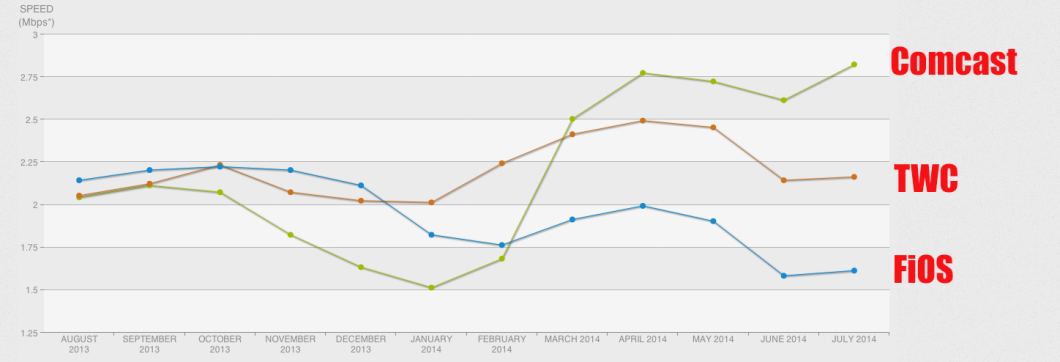Netflix Is Also Paying A Toll To Time Warner Cable To Improve Speeds To Users

The latest Netflix speed data shows that TWC downstream speeds improved after it quietly reached a paid-peering deal with Netflix in June. Meanwhile, FiOS still sucks, in spite of its peering arrangement with Netflix.
The folks at Gigaom noticed a traceroute of a Netflix signal to a TWC customer in New York City skipped directly from Netflix to TWC’s data centers, rather than going the traditional route through and intermediary bandwidth provider.
TWC then confirmed that a so-called paid-peering deal was reached with Netflix earlier this summer and recently began to roll out. That could explain the slight bump in Netflix speeds over TWC’s network in the last month.
Netflix is responsible for the largest chunk of downstream Internet data in the U.S. Until mid-2013, most of that data was carried by bandwidth providers who would hand off Netflix content to Internet Service Providers to carry the “last mile” to customers’ homes. When peering points — the connections between ISPs and bandwidth providers — would become congested during times of heavy use, it was customary for ISPs to open up more connections to alleviate the congestion; much like a supermarket will temporarily open up extra checkout lines to keep customers moving.
But a little more than a year ago, Verizon and others decided to take a hands-off approach to Netflix data, allowing it to bottleneck during times of heaviest use and resulting in substandard streams for Netflix customers.
The ISPs argued that Netflix was taking advantage of their networks by sending so much traffic without paying a toll. Netflix — and many of its customers — contended that ISP customers paid for a certain level of broadband service and Netflix was not to blame for the ISPs’ failure to improve their networks.
But in the end, Netflix capitulated, coming to an agreement with Comcast shortly after the nation’s largest ISP announced it was trying to merge with TWC. Speeds instantly began to improve, but Netflix still maintains that it’s data is being held hostage by the ISPs.
Netflix later made a deal with Verizon, though according to the latest speed data from Netflix, FiOS speeds are still well below the 3MBps that you’d need to stream an HD video. The two have also engaged in a lot of finger-pointing as to why FiOS speeds are still sub-DSL months after reaching a peering deal.
In June, the FCC announced it was going to investigate paid-peering arrangements to see how they affect competition and consumers.
“Consumers pay their ISP and they pay content providers like Hulu, Netflix or Amazon. Then when they don’t get good service they wonder what is going on,” wrote FCC Chair Tom Wheeler at the time. “Consumers must get what they pay for. As the consumer’s representative we need to know what is going on.”
Want more consumer news? Visit our parent organization, Consumer Reports, for the latest on scams, recalls, and other consumer issues.

